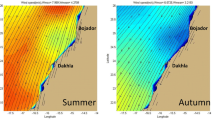Abstract
Kagoshima Bay is an enclosed bay that has the tendency to undergo eutrophication, and a very important site to describe the behavior of open seawater intrusion. According to the results of the satellite SST (Sea Surface Temperature) image analysis or numerical simulation focused on the warm water intrusion into the bay in winter, a warm water mass originates in the meandering Kuroshio Current and reaches the mouth of the bay making the density flow to act like a semi-geostrophic current that is influenced by the Coriolis effect. However, there is still no information on the oceanic intruding flow during the summer, where it is accompanied by thermal stratification. In this research, satellite remote sensing and numerical simulation were employed to investigate the oceanic water intrusion into Kagoshima Bay during the summer season by using satellite chl-a (chlorophyll-a) images instead of SST. As a result, the distribution of the low-concentration chl-a with the oceanic water intrusion was found to be similar to the intrusion that occurs during the winter season. Furthermore, the numerical simulation was performed under the simple assumption that the thickness of the warm water mass that reaches the southern coast of Kyushu also shows the same tendency as in the winter season. Although the characteristics, such as the intruding speed or intruding pattern, are similar in winter, some features such as the generation of the inflow from the middle layer, showed a different tendency.
Similar content being viewed by others
References
Anon., Yearbook of National Water Quality, Kagoshima Prefecture, (2005–2006), 163 and 156.
Kohno, J., Hosotani, K., Ono. Y. and Kikukawa, H., Warm Ocean Water Intrusion into Kagoshima Bay, J. of Visualization, 7–4 2004), 331–340.
Kubokawa, A. and Hanawa, K., A Theory of Semigeostrophic Gravity Waves and its Application to the Intrusion of a Density Current along a Coast, Part 1. Semigeostrophic Gravity Waves, J. Oceanogr. Soc. Japan, 40 (1984), 247–259.
Kubokawa, A. and Hanawa, K., A Theory of Semigeostrophic Gravity Waves and its Application to the Intrusion of a Density Current along a Coast, Part 2. Intrusion of a Density Current along a Coast in a Rotating Fluid, J.Oceanogr. Soc. Japan, 40 (1984), 260–270.
Kobari, T., Habano, A. and Ichikawa, T., Seasonal variations in phyto— and zooplankton biomass in Kagoshima Bay, Mem. Fac. Fisheries, Kagoshima Univ., 51 (2002), 19–25.
Hosotani, K., Behavior of the Warm Ocean Water at the South Coast of Kyushu, J. of Visualization, 9-4 (2006), 427–435.
Hosotani, K. and Kikukawa, H., Analysis of the Warm Ocean Water Intrusion into Kagoshima Bay, J. Remote sens. Soc. Japan, 25-5 (2005), 443–458 (in Japanese).
Miyashita, M., Bi-weekly to Seasonal Variability of Satellite-derived Chlorophyll a Distribution: Controlling Factor in the Ocean South of Honshu Island, J. Remote Sens. Soc. Japan, 25-2 (2005), 169–178.
Ohtani, M., Kikukawa, H., Orita, K., Kohno, J. and Kinoshita K., Ocean Water Inflow into Kagoshima Bay, Oceanogra. Japan, 7 (1998), 245–251 (in Japanese).
Sakurai, M., Maeda, A., Sugimori, Y. and Kubota, M., Process of Water Exchange Through the Mouth of Kagoshima Bay, J.Oceanogra., 9 (2000), 1–13 (in Japanese).
Sakurai, M., Water Exchange through the Mouth of Kagoshima Bay, Bulletin on Coastal Oceanogr., 21 (1983), 45–52 (in Japanese).
Takahashi, W. and Kawamura, H., Detection Method of Kuroshio Front Using the Satellite-Derived Chlorophyll-a Images, Remote Sensing and Environmental Journal, 97 (2005), 83–91.
Author information
Authors and Affiliations
Additional information
Kazunori Hosotani:He received his MS. in Mechanical engineering from Tottori University (1999) and Ph.D. from The United Graduate School of Agricultural Sciences, Kagoshima University (2007). He is currently a part time technical staff at the Faculty of Fisheries, Kagoshima University. His research interests are environmental fluid dynamics.
Gathot Winarso: He worked in the Remote Sensing Center, Indonesian National Institute of Aeronautic and Space. He received his MS. in Fisheries Science from Kagoshima University. And now he is a Doctor al course student of Graduate School of Science and Technology, Nagasaki University. His research interests are satellite remote sensing and oceanography.
Rights and permissions
About this article
Cite this article
Hosotani, K., Winarso, G. Oceanic water intrusion into Kagoshima Bay resulting in thermal stratification. J Vis 10, 325–334 (2007). https://doi.org/10.1007/BF03181700
Received:
Revised:
Issue Date:
DOI: https://doi.org/10.1007/BF03181700



